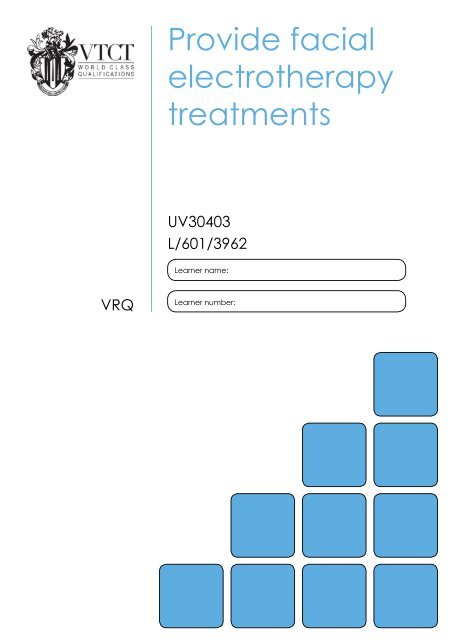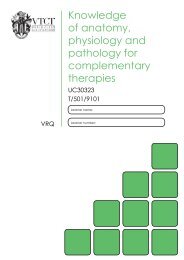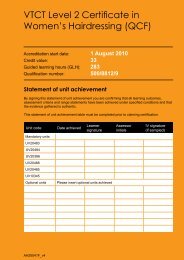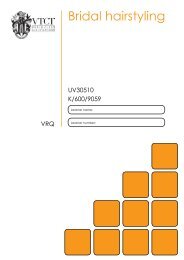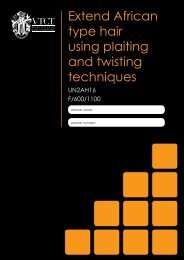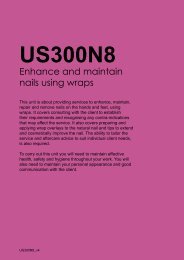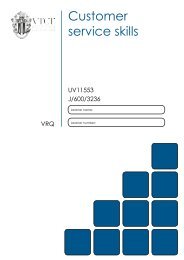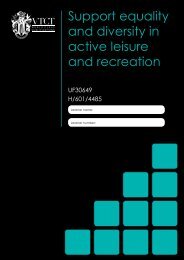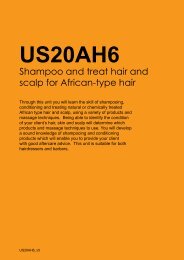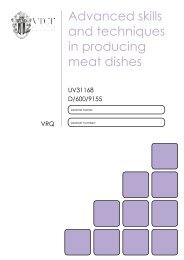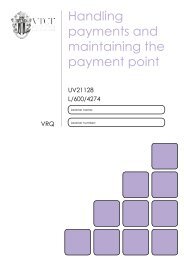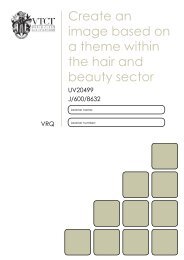UV30403 - VTCT
UV30403 - VTCT
UV30403 - VTCT
You also want an ePaper? Increase the reach of your titles
YUMPU automatically turns print PDFs into web optimized ePapers that Google loves.
VRQ<br />
Provide facial<br />
electrotherapy<br />
treatments<br />
<strong>UV30403</strong><br />
L/601/3962<br />
Learner name:<br />
Learner number:
Statement of unit achievement<br />
<strong>VTCT</strong> is the specialist awarding body for the Hairdressing, Beauty Therapy,<br />
Complementary Therapy and Sport and Active Leisure sectors, with over 45<br />
years of experience.<br />
<strong>VTCT</strong> is an awarding body regulated by national organisations including<br />
Ofqual, SQA, DCELLS and CCEA.<br />
<strong>VTCT</strong> is a registered charity investing in education and skills but also giving to<br />
good causes in the area of facial disfigurement.<br />
By signing this statement of unit achievement you are confirming that all learning outcomes, assessment<br />
criteria and range statements have been achieved under specified conditions and that the evidence<br />
gathered is authentic.<br />
This statement of unit achievement table must be completed prior to claiming certification.<br />
Unit code Date achieved Learner signature<br />
Assessor tracking table<br />
Assessor name Assessor signature<br />
Assessor<br />
initials<br />
Assessors<br />
initials<br />
IV signature<br />
(if sampled)<br />
All assessors using this Record of Assessment book must complete this table. This is required for<br />
verification purposes.<br />
Assessor number<br />
(optional)
<strong>UV30403</strong><br />
Provide facial electrotherapy<br />
treatments<br />
This unit is about improving face and skin condition<br />
using direct high frequency, galvanic, EMS, microcurrent<br />
and lymphatic drainage equipment. You will be required<br />
to formulate a specific course of treatments tailored to<br />
individual client needs.<br />
<strong>UV30403</strong>_v4
Level<br />
Credit value<br />
GLH<br />
3<br />
11<br />
104<br />
Observation(s)<br />
5<br />
External paper(s)<br />
2
Provide facial electrotherapy<br />
treatments<br />
Learning outcomes Evidence requirements<br />
On completion of this unit you will:<br />
1. Be able to prepare for facial treatments<br />
using electrotherapy<br />
2. Be able to provide facial treatments using<br />
electrotherapy<br />
1. Environment<br />
Evidence for this unit must be gathered in a<br />
real or realistic working environment.<br />
2. Simulation<br />
Simulation is not allowed in this unit.<br />
3. Observation outcomes<br />
Competent performance of ‘Observation’<br />
outcomes must be demonstrated to your<br />
assessor on at least five occasions.<br />
4. Range<br />
All ranges must be practically demonstrated<br />
or other forms of evidence produced to<br />
show they have been covered.<br />
5. Knowledge outcomes<br />
There must be evidence that you possess<br />
all the knowledge and understanding<br />
listed in the ‘Knowledge’ section of this<br />
unit. This evidence may include projects,<br />
assignments, case studies, reflective<br />
accounts, oral/written questioning and/or<br />
other forms of evidence.<br />
6. Tutor/Assessor guidance<br />
You will be guided by your tutor/assessor<br />
on how to achieve learning outcomes and<br />
ranges in this unit. All outcomes and ranges<br />
must be achieved.<br />
7. External paper<br />
Knowledge and understanding in this unit<br />
will be assessed by an external paper.<br />
The criteria that make up this paper are<br />
highlighted in white throughout this unit.<br />
There are two external papers that must<br />
be achieved.<br />
<strong>UV30403</strong><br />
3
4<br />
Achieving observations<br />
and range<br />
Achieving observation outcomes<br />
Your assessor will observe your performance<br />
of practical tasks. The minimum number<br />
of observations required is indicated in the<br />
evidence requirements section of this unit.<br />
Criteria may not always naturally occur during<br />
a practical observation. In such instances you<br />
will be asked questions to demonstrate your<br />
competence in this area. Your assessor will<br />
document the criteria that have been achieved<br />
through oral questioning.<br />
Your assessor will sign off an outcome when all<br />
criteria have been competently achieved in a<br />
single client service.<br />
Achieving range<br />
The range section indicates what must<br />
be covered. Ranges should be practically<br />
demonstrated as part of an observation. Where<br />
this is not possible other forms of evidence may<br />
be produced. All ranges must be covered.<br />
Your assessor will document the portfolio<br />
reference once a range has been competently<br />
achieved.<br />
<strong>UV30403</strong><br />
Maximum service times<br />
There are no maximum service times that apply<br />
to this unit.
Outcome 1<br />
You can:<br />
a. Prepare yourself, client and work area for<br />
facial electrotherapy treatments<br />
b. Use suitable consultation techniques to<br />
identify treatment objectives<br />
c. Carry out skin analysis and relevant tests<br />
d. Provide clear recommendations to the client<br />
e. Select products, tools and equipment to<br />
suit client treatment needs, skin types and<br />
conditions<br />
*May be assessed through oral questioning.<br />
Observations<br />
Be able to prepare for facial treatments using electrotherapy<br />
Observation 1 2 3<br />
Date achieved<br />
Criteria questioned orally<br />
Portfolio reference<br />
Assessor initials<br />
Learner signature<br />
Observation<br />
Date achieved<br />
Criteria questioned orally<br />
Portfolio reference<br />
Assessor initials<br />
Learner signature<br />
4 5 Optional<br />
<strong>UV30403</strong> 5
6<br />
Outcome 2<br />
Be able to provide facial treatments using electrotherapy<br />
You can:<br />
a. Communicate and behave in a professional<br />
manner<br />
b. Follow health and safety working practices<br />
c. Position yourself and the client correctly<br />
throughout the treatment<br />
d. Use products, tools, equipment and<br />
techniques to suit client treatment needs,<br />
skin types and conditions<br />
e. Complete the treatment to the satisfaction<br />
of the client<br />
f. Evaluate the results of the treatment<br />
g. Provide suitable aftercare advice<br />
*May be assessed through oral questioning.<br />
Observation<br />
Date achieved<br />
Criteria questioned orally<br />
Portfolio reference<br />
Assessor initials<br />
Learner signature<br />
1 2 3<br />
Observation<br />
Date achieved<br />
Criteria questioned orally<br />
Portfolio reference<br />
Assessor initials<br />
Learner signature<br />
4 5 Optional<br />
<strong>UV30403</strong>
*You must practically demonstrate that you have:<br />
Range<br />
Used all types of equipment Portfolio reference<br />
Galvanic unit<br />
Electro Muscle Stimulator (EMS)<br />
Microcurrent unit<br />
Lymphatic drainage equipment<br />
Used all consultation techniques Portfolio reference<br />
Questioning<br />
Visual<br />
Manual<br />
Reference to client records<br />
Carried out a minimum of 1 of the necessary actions Portfolio reference<br />
Encouraging the client to seek medical advice<br />
Explaining why the treatment cannot be carried out<br />
Modification of treatment<br />
Treated all skin types Portfolio reference<br />
Oily<br />
Dry<br />
Combination<br />
*It is strongly recommended that all range items are practically demonstrated. Where this is not<br />
possible, other forms of evidence may be produced to demonstrate competence.<br />
<strong>UV30403</strong> 7
8<br />
*You must practically demonstrate that you have:<br />
Treated all skin conditions Portfolio reference<br />
Mature<br />
Sensitive<br />
Dehydrated<br />
Congested<br />
Met all treatment objectives Portfolio reference<br />
Improved skin condition<br />
Improved contour and muscle condition<br />
Improved skin texture<br />
Congested<br />
Provided all types of advice Portfolio reference<br />
Avoidance of activities which may cause contra-actions<br />
Future treatment needs<br />
Suitable home care products and their use<br />
*It is strongly recommended that all range items are practically demonstrated. Where this is not<br />
possible, other forms of evidence may be produced to demonstrate competence.<br />
<strong>UV30403</strong>
Achieving knowledge outcomes<br />
You will be guided by your tutor and assessor<br />
on the evidence that needs to be produced.<br />
Your knowledge and understanding will be<br />
assessed using the assessment methods listed<br />
below:<br />
• Observed work<br />
• Witness statements<br />
• Audio-visual media<br />
• Evidence of prior learning or attainment<br />
• Written questions<br />
• Oral questions<br />
• Assignments<br />
• Case studies<br />
Achieving the external paper<br />
Developing knowledge<br />
Where possible your assessor will integrate<br />
knowledge outcomes into practical observations<br />
through oral questioning.<br />
The external papers will test your knowledge of the criteria highlighted in white. A pass mark of<br />
70% must be achieved. Criteria not achieved will be identified to your tutor/assessor. You will then<br />
be orally questioned or asked to produce other forms of evidence as all unit criteria must<br />
be achieved.<br />
Your assessor will complete the following table when the 70% pass mark has been achieved.<br />
Paper Date achieved Assessor initials<br />
1 of 2<br />
2 of 2<br />
<strong>UV30403</strong> 9
10<br />
Knowledge<br />
Outcome 1<br />
Be able to prepare for facial treatments using electrotherapy<br />
You can:<br />
f. Describe salon requirements for preparing yourself, the client and<br />
work area<br />
g. Describe the environmental conditions suitable for facial<br />
electrotherapy treatments<br />
h. Describe the different consultation techniques used to identify<br />
treatment objectives<br />
i. Explain the importance of carrying out a detailed skin analysis and<br />
relevant tests<br />
j. Describe how to select products, tools and equipment to suit client<br />
treatment needs, skin types and conditions<br />
k. Describe the different skin types, conditions and characteristics<br />
l. Explain the contra-indications that prevent or restrict facial<br />
electrotherapy treatments<br />
*Assessor initials to be inserted if orally questioned.<br />
Requirements highlighted in white are assessed in the external paper.<br />
<strong>UV30403</strong><br />
Portfolio reference /<br />
Assessor initials*
Outcome 2<br />
Be able to provide facial treatments using electrotherapy<br />
You can:<br />
h. Explain how to communicate and behave in a professional manner<br />
i. Describe health and safety working practices<br />
j. Explain the importance of positioning yourself and the client<br />
correctly throughout the treatment<br />
k. Explain the importance of using products, tools, equipment and<br />
techniques to suit clients treatment needs, skin type and conditions<br />
l. Describe the effects and benefits of electrotherapy equipment and<br />
products on the skin and underlying structures<br />
m. Explain the principles of electrical currents<br />
n. Describe how treatments can be adapted to suit client treatment<br />
needs, skin types and conditions<br />
o. State the contra-actions that may occur during and following<br />
treatments and how to respond<br />
p. Explain the importance of completing the treatment to the<br />
satisfaction of the client<br />
q. Explain the importance of completing treatment records<br />
r. Describe the methods of evaluating the effectiveness of the<br />
treatment<br />
s. Describe the aftercare advice that should be provided<br />
t. Describe the structure, growth and repair of the skin<br />
*Assessor initials to be inserted if orally questioned.<br />
Requirements highlighted in white are assessed in the external paper.<br />
Portfolio reference /<br />
Assessor initials*<br />
<strong>UV30403</strong> 11
12<br />
Outcome 2 (continued)<br />
Be able to provide facial treatments using electrotherapy<br />
You can:<br />
u. Describe skin types, conditions, diseases and disorders<br />
v. Describe the structure, function, position and action of the head,<br />
neck and shoulder muscles<br />
w. Describe the location, function and structure of the bones of the<br />
head, neck and shoulder<br />
x. Describe the structure and function of the nervous, circulatory and<br />
lymphatic systems for the head, neck and shoulders<br />
y. Explain how the ageing process, lifestyle and environmental<br />
factors affect the condition of the skin and underlying structures<br />
*Assessor initials to be inserted if orally questioned.<br />
Requirements highlighted in white are assessed in the external paper.<br />
<strong>UV30403</strong><br />
Portfolio reference /<br />
Assessor initials*
Unit content<br />
This section provides guidance on the recommended knowledge and skills required to enable you<br />
to achieve each of the learning outcomes in this unit. Your tutor/assessor will ensure you have the<br />
opportunity to cover all of the unit content.<br />
Outcome 1: Be able to prepare for facial treatments using electrotherapy<br />
Management of health and safety at<br />
work: Clean up spillages, report slippery<br />
surfaces, remove/report obstacles,<br />
ensure good all round access to trolleys<br />
and equipment, sterilise/disinfect tools,<br />
equipment and work surfaces, wear<br />
personal protective equipment.<br />
Electricity at work: Checking/visual check<br />
of equipment, no trailing wires, portable<br />
appliance testing (PAT).<br />
Manual handling: Moving stock, lifting,<br />
working heights, unpacking, posture,<br />
deportment, balance weight, preserve<br />
back, prevent slouching.<br />
Towels: Wash regularly, clean for every<br />
client, dirty towels in covered bin.<br />
Liability insurance: Employers, public,<br />
professional indemnity.<br />
Reporting of injuries, diseases and<br />
dangerous occurrences regulations:<br />
Accident book, reporting diseases, local<br />
byelaws, code of conduct, risk assessment.<br />
Control of substances hazardous to<br />
health: Replace lids, ensure ventilation<br />
for vapour and dust, avoid overexposure<br />
to chemicals, use chemicals correctly,<br />
follow storage handling use and disposal,<br />
correctly dispose of contaminated waste/<br />
products (in a closed top bin), check end<br />
date on packaging, store away from heat,<br />
damp and direct sunlight, follow relevant<br />
manufacturers’ instructions, no smoking,<br />
eating or drinking.<br />
Health and safety legislation: Data<br />
protection, electricity at work, employers’<br />
liability (compulsory insurance), fire<br />
precautions, first aid at work, health<br />
and safety at work, local government<br />
miscellaneous provisions, occupiers’<br />
liability, local byelaws.<br />
Regulations: Control of substances<br />
hazardous to health regulations,<br />
management of health and safety at work<br />
regulations, manual handling, personal<br />
protective equipment, reporting of injuries,<br />
diseases and dangerous occurrences<br />
regulations, workplace (health and welfare)<br />
regulations.<br />
Hazards and risks: A hazard is something<br />
that has the potential to cause harm. A risk<br />
is the likelihood of a hazard happening.<br />
Employer responsibility: Current and<br />
valid liability insurance, display health and<br />
safety rules (covering staff, employees,<br />
clients and fire evacuation), provide<br />
regular training, accurate record keeping,<br />
monitoring.<br />
Hazards: Something with potential to<br />
cause harm, requiring immediate attention,<br />
level of responsibility, report, nominated<br />
personnel, duty to recognise and deal with<br />
hazards.<br />
Equipment: Only used for intended<br />
purpose, safe usage, handling, storage,<br />
cleaning, lifting, visual checks, worn, faulty,<br />
repairs, maintenance, portable appliance<br />
testing, correct disposal of contaminated<br />
waste, records.<br />
Security (cash): Staff training, point of<br />
sale, regular banking, in transit.<br />
<strong>UV30403</strong> 13
14<br />
Outcome 1: Be able to prepare for facial treatments using electrotherapy<br />
(continued)<br />
Security (people): Staff, clients, visitors,<br />
children, personal belongings, systems<br />
(security, emergency evacuation, storage,<br />
client records, business information).<br />
Risk: Likelihood of a hazard happening,<br />
risk assessment, determine the level of<br />
risk, preventative measures, reduce a<br />
potentially harmful situation, judgement of<br />
salon hazards, who/what is at risk, level of<br />
risk, interpret results, conclusions, record<br />
findings, regular reviews.<br />
Reasons for risk assessment: Staff,<br />
visitors, client health and safety, safe<br />
environment, minimise hazards and risks,<br />
requirement of legislation.<br />
Hygiene:<br />
General – sterilise and sanitise tools,<br />
disinfect work surfaces, cover cuts and<br />
abrasions, sanitise therapist’s hands before<br />
and after treatments, sanitise with sprays<br />
and gels, clean towels between clients,<br />
place dirty towels in covered bin, use<br />
disposable towels, dispense products with<br />
a spatula, pump or spray, use disposables<br />
wherever possible, no smoking, personal<br />
hygiene, replace loose lids, uncapped<br />
bottles and pots.<br />
Disinfection – heat or chemical methods,<br />
bactericides, fungicides, viricides, UV<br />
cabinet for storage only.<br />
Disposal of waste – single use items,<br />
pedal bin with a liner, spillages and unused<br />
chemicals, contaminated waste, hazardous<br />
waste, environmental protection.<br />
Therapist posture and deportment:<br />
Correct posture when sitting, lifting and<br />
carrying, working methods to avoid<br />
Repetitive Strain Injury (RSI), hand<br />
exercises, standing posture, even weight<br />
<strong>UV30403</strong><br />
distribution, client comfort, maintain<br />
modesty, client correctly positioned to get<br />
maximum benefit from treatment, ensure<br />
technician positioning delivers appropriate<br />
techniques, appropriate space between<br />
client and technician, prevent injury,<br />
optimum results, allow for visual checks.<br />
Work area: Clean and hygienic, height<br />
adjustable chair, correct posture, correct<br />
couch height, lighting, ventilation, noise,<br />
music, temperature, ambience, no trailing<br />
wires, no obstructions, tools and equipment<br />
in a safe working position for therapist.<br />
Client preparation: Protect client clothing,<br />
client comfort, privacy, modesty, client<br />
positioned correctly.<br />
Communication:<br />
Verbal – speaking manner and tone,<br />
professional, supportive, respectful,<br />
sensitive to client, open questioning related<br />
to treatment.<br />
Non-verbal – eye contact, body language,<br />
listening.<br />
Record keeping: Accurate appointment<br />
systems, stationery, loyalty, rewards,<br />
acknowledgement of occasions,<br />
consultation record keeping,<br />
contra-indications, signatures, refer to<br />
existing records, information clear, accurate<br />
and in logical order (name, address,<br />
contact numbers, age range, reason for<br />
treatment, occupation, sport/hobbies,<br />
medical history, allergies/hypersensitivity,<br />
contact lenses, contra-actions,<br />
contra-indications, skin sensitivity<br />
tests, adaptations and modifications,<br />
recommendations, requirements, treatment<br />
plan), update record at the end of the<br />
treatment, update at each visit, maintained<br />
electronically, paper records.
Outcome 1: Be able to prepare for facial treatments using electrotherapy<br />
(continued)<br />
Professional appearance: Clean<br />
professional uniform, no jewellery, no<br />
piercings, hair neatly tied back, fringe<br />
secured, closed in footwear, make-up<br />
(light day make-up), personal hygiene and<br />
cleanliness (shower/bath, cover cuts and<br />
abrasions, deodorant or antiperspirant),<br />
oral hygiene (clean teeth, fresh breath),<br />
nails (good condition and maintained).<br />
Professional ethical conduct: Polite,<br />
cheerful and friendly manner (friendly facial<br />
expressions, positive attitude, eye contact,<br />
open body language), client relations,<br />
confidentiality, respect for colleagues and<br />
competitors, avoid gossip, take pride in<br />
work, punctuality, employer and client<br />
loyalty.<br />
Treatment objectives: Improved skin<br />
condition, improved contour and muscle<br />
tone, lymphatic drainage, relaxation, client<br />
needs and suitability, client agreement,<br />
realistic outcome, cost, duration and<br />
frequency of treatments, further treatments.<br />
Skin analysis: Carried out using<br />
magnifying lamp, protect eyes with damp<br />
cotton wool pads, check all areas of the<br />
face and neck for skin type, skin conditions<br />
and characteristics, record results on<br />
record card, client skin type, conditions<br />
and characteristics, treatment plan, most<br />
suitable treatment, suitable products,<br />
prevent worsening of conditions, accurate<br />
aftercare advice, future treatment needs.<br />
Skin types: Normal, oily, dry.<br />
Skin conditions: Mature, sensitive,<br />
dehydrated, congested.<br />
Examples of skin imperfections: Broken<br />
capillaries, pustules, papules, milia,<br />
comedones, open pores, fine lines and<br />
wrinkles.<br />
Skin characteristics:<br />
Sensitive – often pale skin, dry, colour<br />
easily, redness, react to products.<br />
Dehydrated – normal sebaceous<br />
secretions but still flaky, tight.<br />
Mature – loss of elasticity, lose muscle<br />
tone, wrinkles.<br />
Normal – fine texture, no visible pores,<br />
smooth, supple, flexible.<br />
Oily – shiny, slight thickening, sallow,<br />
coarse texture, enlarged pores, congestion,<br />
comedones.<br />
Combination – combination of two or more<br />
skin types, usually oily T-zone, normal or<br />
dry on cheeks.<br />
Dry – lacks moisture, dry to touch,<br />
flakiness, fine texture, thin, tight, small<br />
pores, broken capillaries, ageing.<br />
Skin sensitivity tests: Tactile test for<br />
sharp and blunt, thermal test for hot and<br />
cold.<br />
Tactile – use a sharp (orange stick) and<br />
smooth (cotton pad) object, stroke over the<br />
skin in area to be treated. Client should be<br />
able to differentiate between the different<br />
sensations.<br />
Thermal – fill test tube with cold water and<br />
one with hot water, place on skin in area<br />
to be treated. Ask client to differentiate<br />
between the sensations.<br />
Skin sensitivity test – record results.<br />
Skin sensitivity test (interpret results)<br />
– client should be able to identify the<br />
difference between sharp/blunt and hot/<br />
cold. If the client can, treatment can go<br />
ahead, but if client is unresponsive to<br />
tactile and thermal tests, treatment should<br />
<strong>UV30403</strong> 15
16<br />
Outcome 1: Be able to prepare for facial treatments using electrotherapy<br />
(continued)<br />
not be carried out (client would not be able<br />
to feel if electrical current was too high, risk<br />
of skin damage).<br />
Explain the treatment to the client:<br />
Treatment process, expected sensations,<br />
skin reaction, outcomes, further treatments.<br />
Equipment maintenance: Checked for<br />
damage, dials, leads and plugs checked,<br />
no trailing wires, dials at zero before<br />
starting, test before use on client, only<br />
turn up current during treatment, check<br />
with client throughout for comfort and<br />
sensitivity, stay with client, always follow<br />
manufacturer’s instructions for each<br />
machine.<br />
Environmental conditions: Heating<br />
(warm), lighting (soft), noise level and<br />
music selection (relaxing), ventilation<br />
sufficient, pleasant aroma, privacy of<br />
work area, client comfort, health, safety<br />
and hygiene requirements maintained<br />
throughout treatment.<br />
Examples of contra-indications that<br />
may prevent treatment: Contagious skin<br />
diseases and disorders, dysfunction of the<br />
nervous system, heart disease/disorder,<br />
undergoing medical treatment, pacemaker,<br />
any cancer related treatments, recent scar<br />
tissue, undiagnosed lumps or swellings,<br />
inflammation, medication causing thinning<br />
or inflammation of the skin (e.g. steroids,<br />
accutane, retinol), diagnosed scleroderma.<br />
Examples of contra-indications that may<br />
restrict treatment: Micropigmentation,<br />
botox, dermal fillers, diabetes, epilepsy,<br />
high/low blood pressure, history of<br />
thrombosis or embolism, metal pins or<br />
plates, medication, pregnancy, piercing,<br />
anxiety, varicose veins, cuts, abrasions,<br />
bruises, recent dermabrasion, recent<br />
chemical peels, IPL, laser or epilation.<br />
<strong>UV30403</strong>
Outcome 2: Be able to provide facial treatments using electrotherapy<br />
Products (galvanic unit): Cleanser,<br />
toner, moisturiser, exfoliant, ampoules (if<br />
required) desincrustation gel, iontophoresis<br />
gel, masks.<br />
Products (EMS unit): Moisturiser,<br />
exfoliant, conducting solution (using<br />
manufacturer’s instructions), masks.<br />
Products (lymphatic drainage unit):<br />
Cleanser, toner, moisturiser, exfoliant,<br />
lubricant (oil/cream), masks.<br />
Products (high frequency unit):<br />
Cleanser, toner, moisturiser, exfoliant,<br />
massage cream, oxygenating cream or<br />
talc, masks.<br />
Products (microcurrent treatment):<br />
Cleanser, toner, moisturiser, exfoliant,<br />
non-surgical face lifting gel masks (using<br />
manufacturer’s instructions), paper cotton<br />
buds (if required).<br />
Tools: Spatula, facial sponges, mask<br />
brush.<br />
Equipment: Headband, large towel/<br />
blanket to protect client, couch, stool or<br />
chair, trolley, bin with liner, cotton wool,<br />
bowl, mirror, magnifying lamp, tissues,<br />
machines (EMS, lymphatic drainage unit,<br />
high-frequency, galvanic, microcurrent) and<br />
all relevant leads, electrodes, pads and<br />
ventouse.<br />
Selection process: Choice based on skin<br />
type, condition, fatty tissue, muscle tone,<br />
client needs, target areas of treatment.<br />
Treatment techniques:<br />
Electro Muscle Stimulator (EMS) –<br />
damp, solution applied (dependant on<br />
manufacturer’s instructions), flat to skin<br />
surface, apply to motor point of muscle,<br />
(intensity, frequency, timing, contraction<br />
and relaxation as per client comfort), area<br />
being worked, manufacturer’s instructions.<br />
Maintain electrodes – electrodes should<br />
be cleaned with damp cotton wool and<br />
surgical spirit at end of each treatment and<br />
should not be immersed in water.<br />
Ventouse – size/type appropriate to area<br />
being worked, no more than 20% skin<br />
suction, upward towards lymph node,<br />
remove suction at end of stroke with finger<br />
under cup or finger released from hole.<br />
Maintenance of ventouse – cleaned in<br />
warm soapy water, immersed in sterilising<br />
fluid or wiped with surgical spirit.<br />
Galvanic – application of desincrustation/<br />
iontophoresis gel/solution.<br />
Galvanic electrode preparation – client<br />
holds indifferent electrode, wrapped in a<br />
damp sponge envelope, use roller, ball or<br />
tweezer electrodes dependant on area,<br />
keep electrode moving, do not break<br />
contact with client’s skin, follow timings and<br />
intensity identified by manufacturer.<br />
Maintenance of galvanic electrodes:<br />
Clean with damp cotton wool to remove<br />
any product, wipe over with surgical spirit,<br />
do not immerse in water, sponge cover can<br />
be rinsed in water.<br />
Direct high-frequency – application<br />
of cream or talc, electrode should be in<br />
contact with skin, keep electrode moving,<br />
treatment timing relevant to skin type.<br />
Indirect high-frequency – application of<br />
massage cream/oil, client holds saturator<br />
electrode, apply generally, massage,<br />
remove product with damp sponges.<br />
Maintenance of high frequency<br />
electrodes: Remove excess product,<br />
cleanse with surgical spirit or suitable<br />
disinfectant, do not immerse in water.<br />
<strong>UV30403</strong> 17
18<br />
Outcome 2: Be able to provide facial treatments using electrotherapy<br />
(continued)<br />
Microcurrent – used with appropriate<br />
lubricant, follow manufacturer’s<br />
instructions, electrodes used following<br />
manufacturer’s diagrams, intensity and<br />
frequency.<br />
Maintenance of microcurrent electrodes:<br />
Remove excess product, cleanse with<br />
surgical spirit or suitable disinfectant, do<br />
not immerse in water.<br />
Electrical current: Alternating current<br />
– interrupted current, changing direction<br />
of flow, direct current – uses effects of<br />
polarity, constant flow in one direction,<br />
chemical action, anode (+) and cathode<br />
(-) frequency and electrons, bi-phasic and<br />
mono-phasic.<br />
Treatment adaptations: Adjust treatment<br />
to suit skin sensitivity, visual erythema,<br />
intensity turned down, timing shortened,<br />
frequency of treatment, combination of<br />
electrical equipment, products applied<br />
to the skin, adjust intensity over specific<br />
areas.<br />
EMS treatment technique:<br />
Possible effects – improved firmness<br />
of facial muscles, improved circulation,<br />
increased metabolism of stimulated<br />
muscles, waste products more readily<br />
removed from muscles.<br />
Possible benefits – improved skin<br />
condition for mature clients/clients who lack<br />
muscle tone.<br />
Possible contra-actions – muscle fatigue<br />
(over stimulation of muscles, gentle<br />
massage over area), erythema (apply cold<br />
compress).<br />
Galvanic treatment technique:<br />
Possible effects – increased blood and<br />
<strong>UV30403</strong><br />
lymphatic circulation, improved function<br />
of skin, improved appearance of skin,<br />
improved texture (through desquamation),<br />
skin types and conditions treated through<br />
application of specific gels/ampoules,<br />
dispersal of waste products and fluid from<br />
area.<br />
Possible benefits – clients with specific<br />
skin condition, improved skin appearance,<br />
deep cleansing.<br />
Possible contra-actions – burn (sterile<br />
cold water), excessive erythema (apply<br />
cooling/soothing mask).<br />
High-frequency (direct) treatment<br />
technique:<br />
Possible effects – warm skin, increased<br />
circulation, lymphatic circulation and<br />
metabolism to the area, stimulation of<br />
nerve endings, germicidal effect, drying<br />
effect.<br />
Possible benefits – improved skin<br />
condition for oily skin conditions, mild acne,<br />
sluggish skins.<br />
Possible contra-actions – excessive<br />
erythema (cold compress, apply cooling/<br />
soothing mask), tissue destruction (caused<br />
by sparking).<br />
High-frequency (indirect) treatment<br />
technique:<br />
Possible effects – increased sebaceous<br />
activity, improved circulation, lymphatic<br />
circulation and drainage.<br />
Possible benefits – dry/dehydrated skins,<br />
improved skin appearance, soften/plump<br />
fine lines and wrinkles.<br />
Possible contra-actions – excessive<br />
erythema (cold compress, apply cooling/<br />
soothing mask), tissue destruction (caused
Outcome 2: Be able to provide facial treatments using electrotherapy<br />
(continued)<br />
by sparking).<br />
Lymphatic drainage treatment<br />
technique:<br />
Possible effects – improved blood<br />
and lymphatic circulation, stimulation<br />
of sluggish skin, reduced oedema,<br />
desquamation and fine lines.<br />
Possible benefits – mature clients, dry<br />
skin conditions, improved skin appearance.<br />
Possible contra-actions – bruising<br />
(caused by high pressure, pulling cup off<br />
skin, over treatment, stationary cup for too<br />
long, apply cold compress), over-stretching<br />
of skin (caused by over treatment, high<br />
pressure over loose skin).<br />
Microcurrent treatment technique:<br />
Possible effects – improved blood<br />
circulation, improved lymphatic circulation,<br />
improved muscle and skin tone, stimulates<br />
cellular function, treatment of fine lines and<br />
wrinkles.<br />
Possible benefits – mature clients,<br />
improved skin appearance, improved facial<br />
contours, fine lines and wrinkles.<br />
Possible contra-actions – muscle fatigue<br />
(caused by incorrect intensity or frequency,<br />
apply gentle massage).<br />
Evaluation and client satisfaction:<br />
Agree result verbally and written through<br />
client feedback on record card, client<br />
objective, results of treatment, before and<br />
after photos, future treatments, record<br />
adjustments for next treatment, accurately<br />
record details on record card.<br />
Skin:<br />
Epidermis – stratum germinativum,<br />
stratum spinosum, stratum granulosum,<br />
stratum lucidum, stratum corneum.<br />
Dermis – blood/lymph supply, papillary<br />
layer, reticular layer, collagen, elastin,<br />
macrophages, adipocytes, mast cells,<br />
fibroblasts, hair, dermal papilla, sebaceous<br />
glands and sebum, arrector pili muscle,<br />
sweat glands (eccrine and apocrine,<br />
sensory nerve endings).<br />
Hypodermis – subcutaneous layer,<br />
adipose tissue, adipocytes.<br />
Functions of the Skin: Secretion,<br />
heat regulation, absorption, protection,<br />
elimination, sensation, vitamin D<br />
production, melanin production.<br />
Understand the process of keratinisation.<br />
Examples of skin diseases and<br />
disorders:<br />
Congenital – eczema, psoriasis.<br />
Bacterial – acne vulgaris, acne rosacea,<br />
folliculitis, boils (furuncles), impetigo.<br />
Viral – warts, verruca, herpes simplex<br />
(HSV), herpes zoster.<br />
Fungal – tinea (pedis, corporis, ungium).<br />
Infestations – scabies, pediculosis<br />
(capitas, pubis).<br />
Pigmentation – vitiligo, albinism,<br />
chloasma, ephelides, lentigo, papilloma,<br />
naevae, port wine stains.<br />
Others – basal cell carcinoma, squamous<br />
cell carcinoma, malignant melanomas.<br />
Cells and tissue (structure): Cell<br />
membrane, nucleus, cytoplasm,<br />
mitochondria, ribosomes, golgi apparatus,<br />
rough and smooth endoplasmic reticulum.<br />
Cells and tissue (functions): Metabolism,<br />
respiration, growth, excretion, movement,<br />
irritability, reproduction.<br />
<strong>UV30403</strong> 19
20<br />
Outcome 2: Be able to provide facial treatments using electrotherapy<br />
(continued)<br />
Position of bones: Shoulder girdle<br />
(clavicle, scapula), skull (frontal, occipital,<br />
parietal, sphenoid, ethmoid, temporal,<br />
nasal, zygomatic, maxilla, mandible,<br />
lacrimal, turbinator, palatine, vomer, hyoid).<br />
Skeletal functions: Support, joints,<br />
movement, protection, attachment, mineral<br />
source, blood cell formation.<br />
Muscle functions: Contraction, relaxation,<br />
attachment, movement (flexion, extension,<br />
abduction, adduction, supination, pronation,<br />
rotation, circumduction, inversion, eversion,<br />
plantarflexion, dorsiflexion), tone, tension,<br />
fatigue.<br />
Muscles of the head, face and neck:<br />
Buccinator, corrugator, depressor labii<br />
anguli, depressor labii inferioris, frontalis,<br />
levator anguli oris, levator labii superioris,<br />
levator palpebrae, levator scapula,<br />
masseter, mentalis, nasalis, occipitalis,<br />
orbicularis oculi, orsicularis oris, platysma,<br />
procerus, pterygoids, risorius, sterno-cleido<br />
mastoid, temporalis, zygomaticus.<br />
Nervous system (functions): Respond to<br />
stimuli, process sensory information, sense<br />
change (internal/external).<br />
Nervous system (structure): Central<br />
nervous system, peripheral nervous system<br />
(somatic/autonomic).<br />
Circulatory system:<br />
Functions of blood – transport, regulation,<br />
protection.<br />
Arteries – internal and external carotid,<br />
occipital, temporal, facial.<br />
Veins – internal and external jugular,<br />
occipital, temporal, subclavian.<br />
Blood composition – erythrocytes,<br />
leucocytes, thrombocytes, plasma.<br />
<strong>UV30403</strong><br />
Circulation – heart, pulmonary circulation,<br />
capillaries, systemic circulation.<br />
Lymphatic system:<br />
Functions of the lymphatic system –<br />
fluid distribution, fighting infection, transport<br />
of fat.<br />
Functions of lymph nodes – filter toxins,<br />
clean lymphatic fluid, antibodies and<br />
antitoxins, produce lymphocytes.<br />
Position of lymph nodes – occipital,<br />
mastoid, superficial cervical, deep cervical,<br />
parotid, buccal, submental, submandibular.<br />
Ageing process: Loss of elasticity,<br />
dryness of skin, cell regeneration slows,<br />
thinning of skin, broken capillaries, slack<br />
muscle tone, poor circulation, waste<br />
product removal slows, less fatty tissue,<br />
irregular pigmentation.<br />
Lifestyle factors that affect skin:<br />
Occupation, diet and fluid intake, sleep<br />
patterns, smoking, exercise, hobbies, home<br />
situation, stress levels, medication, illness,<br />
premature ageing, poor skin condition,<br />
loss of muscle tone, dehydration, poor<br />
circulation, excess fatty tissue, increased<br />
cellulite, slow metabolism, cell regeneration<br />
and growth.<br />
Environmental factors that affect skin:<br />
UV light, weather, central heating, drugs,<br />
alcohol, serious illness, medication,<br />
occupation, dry, dehydrated, premature<br />
ageing, wrinkles and loss of elasticity,<br />
slower metabolism.<br />
Aftercare advice: No make-up (for 24<br />
hours), no further facial treatments (for 24<br />
hours), use cleanser, toner and moisturiser<br />
am/pm, eye cream, neck cream, avoid UV<br />
light/heat/swimming (for 24 hours), drink<br />
plenty of water, regular/further treatments.


